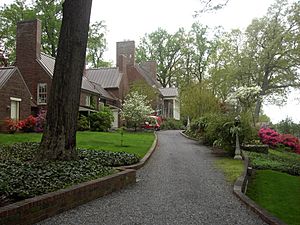St. Helena Island (Maryland) facts for kids
Quick facts for kids
St. Helena Island, Maryland
|
|
|---|---|
| Country | |
| State | |
| County | |
| Elevation | 52 ft (16 m) |
| Time zone | UTC-5 (Eastern (EST)) |
| • Summer (DST) | UTC-4 (EDT) |
| ZIP code |
21032
|
| Area code(s) | 410 |
St. Helena Island is a small island located in the Severn River in Maryland. It sits between two bays, Round Bay and Little Round Bay. The island is about 5 miles (8 km) from Annapolis, Maryland and 17 miles (27 km) south of Baltimore, Maryland.
Contents
Island History: From Ancient Times to Today
Early People on St. Helena
For a very long time, people have lived on St. Helena Island. Scientists have found pieces of clay pots, stone tools, and axes. These items show that Native American groups, including those from the Woodland period, used the island. It's believed that St. Helena and other small islands helped people hide from raiding groups like the Susquehannocks.
First Records and Owners
The first official mention of the island in Anne Arundel County, Maryland records was in 1843. At that time, it was part of the property of Major Richard I. Jones. Later, in 1895, an article in The Washington Post mentioned people visiting the island for fishing. However, the island became much more active about 40 years later.
Paul Burnett's Era: The Mansion and Hospital
In the late 1920s, a lawyer and insurance executive named Paul Burnett bought the island. Some people thought he named it "St. Helena" after a relative of Napoleon Bonaparte. But old maps from 1846 and 1860 already show the island with that name.
Between 1929 and 1931, Burnett built a large mansion on the island. It was designed to look like the Homewood Museum in Baltimore. He used special boats to bring tons of bricks to the island for building. The mansion has a grand design with six fireplaces, each made of different marble from Europe. Many floors are made of marble checkerboards or thick mahogany wood. The house also has several hidden safes built into its walls.
Burnett also used other buildings on the island to create a hospital for children with physical challenges. This hospital operated from 1936 to 1943. In total, there are 22 buildings on the island. There's also a round brick water tower that has been turned into an office with a great view.
The Island Club and Later Owners
After Paul Burnett passed away in 1944, Eugene Raney bought the island. He was a businessman who owned bowling alleys. Raney rented out some buildings, and one became a restaurant. During this time, St. Helena became known for its popular island club. Important people, including members of Congress and Governor William Preston Lane Jr., often visited.
In 1956, the island was divided and sold to different owners. Eugene Raney and his wife continued to use the brick mansion as their vacation home. They often let friends and business partners use it too.
A Fire and New Families
In 1961, Judge Stedman Prescott Jr. bought the mansion. A fire almost destroyed his home that year due to faulty electrical equipment. Nearly 100 firefighters rushed to the island by private boats to put out the fire.
In the late 1990s, a man named Keith Osborne bought the mansion. He wanted to use the 6.5-acre (2.6-hectare) property for weddings and events. Many neighbors were against this idea. The Severn River Association voted to oppose all commercial activities on the island.
Today, the Hartman and Pinkard families still own St. Helena Island. The Hartman family's part of the island, which includes the 1929 mansion, was for sale in 2014.
Island Geography
St. Helena Island is surrounded by water. To its east and south is Round Bay, which is about 2 miles (3 km) wide. This is the widest part of the Severn River. To the north and west is Little Round Bay. This smaller bay might have been a winding part of the river when sea levels were lower. Two creeks, Maynadier and Hopkins, are located southwest of the island.
The island has steep cliffs on its western, northern, and northeastern sides, ranging from 30 to 50 feet (9 to 15 meters) high. There's a beach about 10 to 15 feet (3 to 4.5 meters) wide on the western side and in a small cove on the northeast side. The highest point on the island is 52 feet (16 meters) above sea level. St. Helena has only lost about 2 acres (0.8 hectares) of its land in the last 150 years.
Island Wildlife
St. Helena Island is a great place for many different animals, especially birds! You can see various types of ducks, geese, and tall great blue herons. Other birds like kingfishers and ospreys also live here. In the past, the island was even home to a deer park.


